Discover the essence of India's protected areas, management insights, and global conservation ideals. Uncover a world of biodiversity preservation and sustainability.
According to the definition given by IUCN (International Union for Conservation of Nature) protected area is a clearly defined geographical space, recognised, dedicated and managed, through legal or other effective means, to achieve the long term conservation of nature with associated ecosystem services and cultural values.
Protected areas play a crucial role in conservation of biodiversity, preservation of ecosystem services for people etc. Protected areas in India are those in which human occupation or at least the exploitation of resources is limited. Numerous international conventions and domestic laws established in India regulate the governance of these protected areas within the country.
A National Wildlife Information System (NWIS) on the nation’s Protected Areas has been developed by the Wildlife Institute of India’s (WII) National Wildlife Database Centre. India’s network of 1014 Protected Areas, which includes 106 National Parks, 573 Wildlife Sanctuaries, 115 Conservation Reserves, and 220 Community Reserves, covers 1,75,169.42 km2, or around 5.32%, of the country’s total land area as of November 27, 2023.
| Category | Number |
|---|---|
| National Parks | 106 |
| Wildlife Sanctuaries | 573 |
| Conservation Reserves | 115 |
| Community Reserves | 220 |
| Total | 1014 |
India has a network of 998 Protected Areas covering about 5.28% of its total geographic area. Protected areas in India have been categorised according to the Wildlife Protection Act 1972. It categorised protected areas into four categories:
For the UPSC CSE exam this topic has high relevance so now let us look at each category of protected areas in India in brief for better understanding of the topic.
A national park is a protected area officially identified by the state government to conserve its ecological, faunal, floral, geomorphological, or zoological significance. It is categorised in the second schedule of the IUCN list. The power to declare national parks lies with both the central and state governments, highlighting the joint responsibility for preserving these critical areas. Hailey National Park was established in 1936 as India’s first national park. It is now known as the Jim Corbett National Park in Uttarakhand. For example Papikonda, Dihing Patkai, Gir etc are some National Parks in India.
National parks as a world commission on protected areas enforce strict regulations on human activities within their precincts. Despite these restrictions, certain activities can be permitted by the Chief Wildlife Warden on conditions specified in Wildlife Protection Act 1972. This flexible approach strikes a balance, allowing controlled human intervention while prioritizing the overarching goal of maintaining the ecological integrity of the national park.
The boundaries of National parks are fixed and defined. Once a protected area in India is declared a national park then their status cannot be altered to that of a ‘sanctuary,’ underscoring their lasting and pivotal role in conservation efforts. National parks are given the highest level of protection.
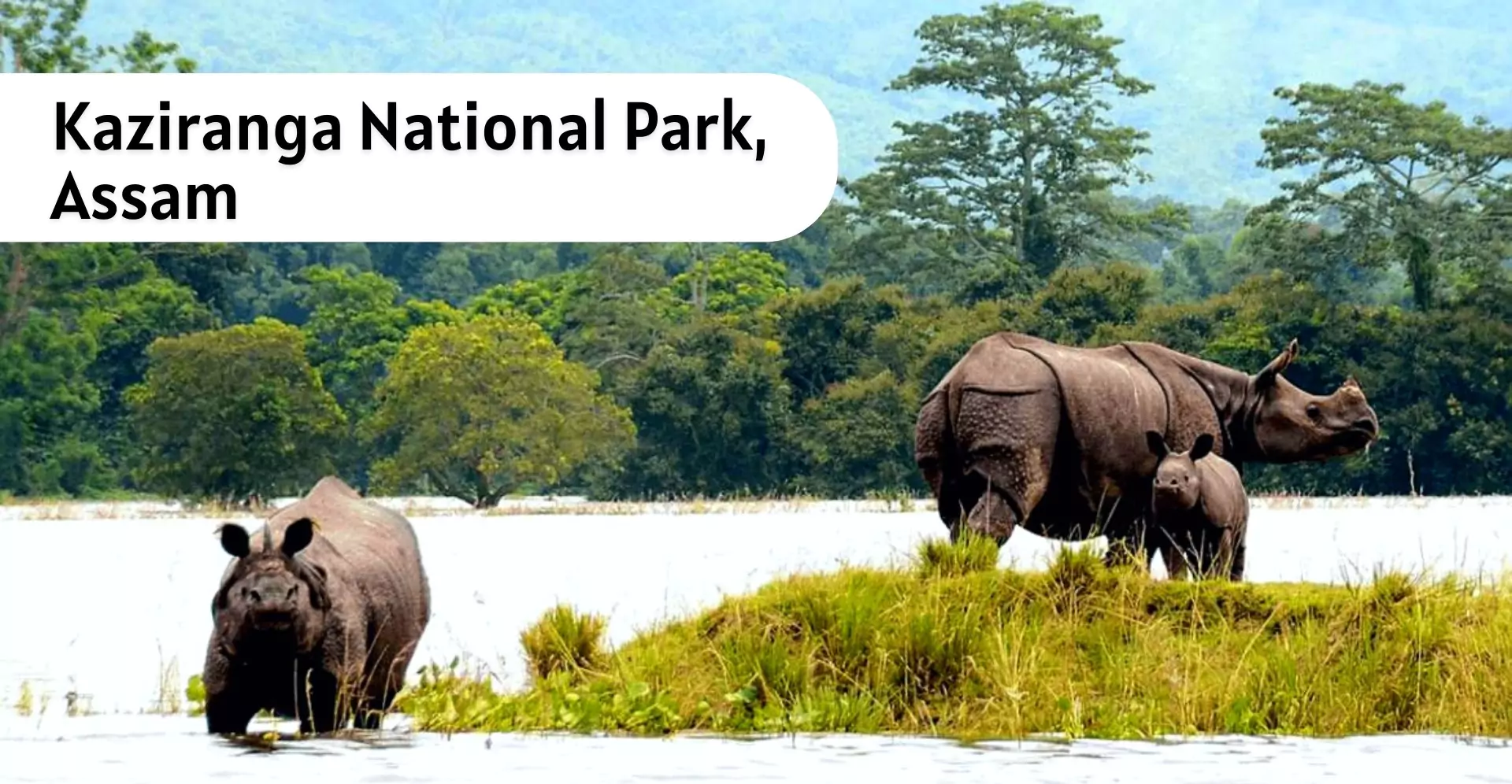
Kaziranga National Park, Assam
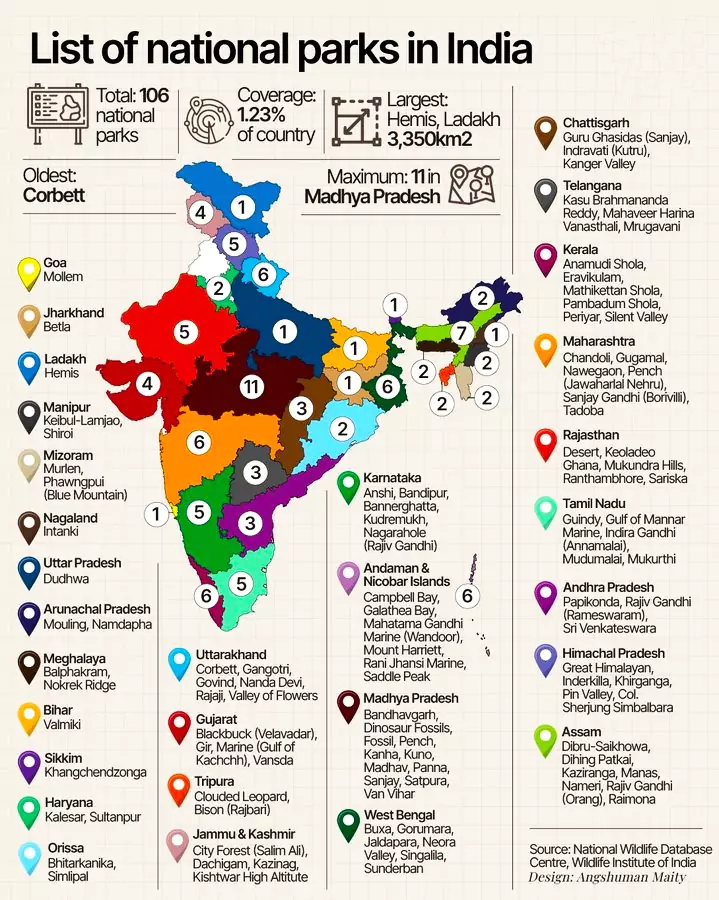
Check Out UPSC CSE Books
Visit PW Store
A wildlife sanctuary, characterized by its significant ecological, faunal, floral, geomorphological, or zoological attributes, is declared to safeguard, propagate, or enhance wildlife and its environment. Within these sanctuaries, certain rights of residents may be permitted, creating a balanced approach to conservation. Wildlife sanctuaries in India are classified as IUCN Category IV protected areas in India, highlighting their importance for conservation.
India has 570 wildlife sanctuaries, covering a substantial area of 122,509.33 km², which accounts for 3.73% of the country’s geographical expanse.
A wildlife sanctuary is a designated area owned by the government or a private entity, aimed at safeguarding specific species of plants or animals, either seasonally or throughout the year. A Wildlife Sanctuary has the potential to be elevated to National Park status, but the reverse, degrading a National Park into a Wildlife Sanctuary, is not permissible.
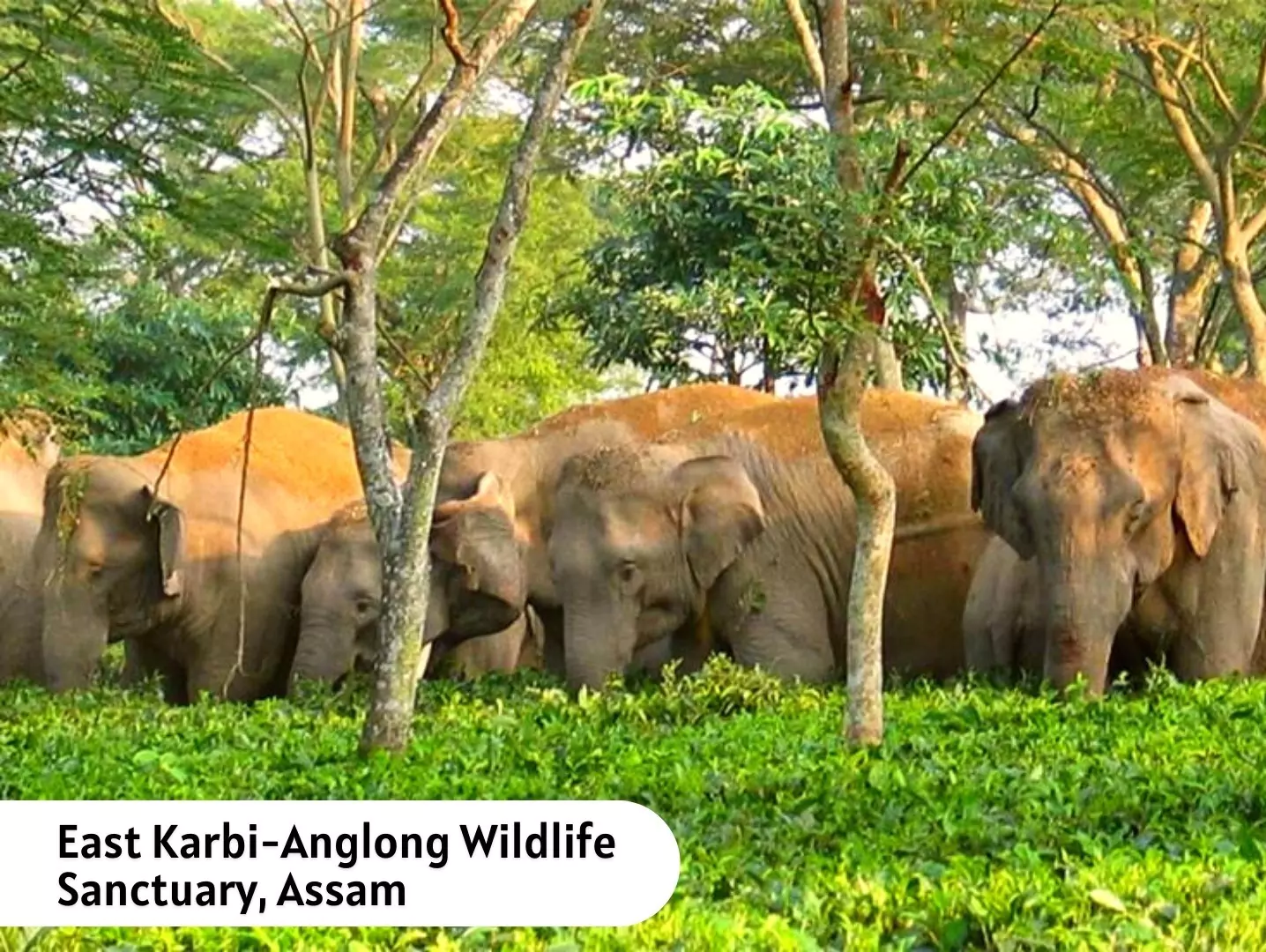
East Karbi-Anglong Wildlife Sanctuary, Assam
| Parameters | National Park | Wildlife Sanctuary |
| Degree of protection | Greater | Lesser |
| Statute | WPA 1972 | WPA 1972 |
| Activities like grazing of livestock, hunting, forestry etc. | Prohibited | Allowed |
| Established for a particular species | No (habitat specific conservation) | Yes (species specific conservation) |
| Protected area management under IUCN | Category II | Category IV |
| Difference in conservation | The difference in conservation value of a National Park from that of a sanctuary is not specified in the WPA 1972. | |
It can be declared by the State Governments in any area owned by the Government, particularly the areas adjacent to National Parks and Sanctuaries and those areas which link one Protected Area with another. Such a declaration should be made after having consultations with the local communities.
Conservation Reserves are declared for the purpose of protecting landscapes, seascapes, flora and fauna and their habitat. The rights of people living inside a Conservation Reserve are not affected. There are 100 existing conservation reserves in India, covering an area of 4927.28 km2, or 0.15 percent of the country’s geographical area.
Conservation reserves act as buffer zones between established national parks, wildlife sanctuaries and reserved and protected forests of India. For Example- Bankapur Peacock Conservation Reserve, Beas River Conservation Reserve etc.
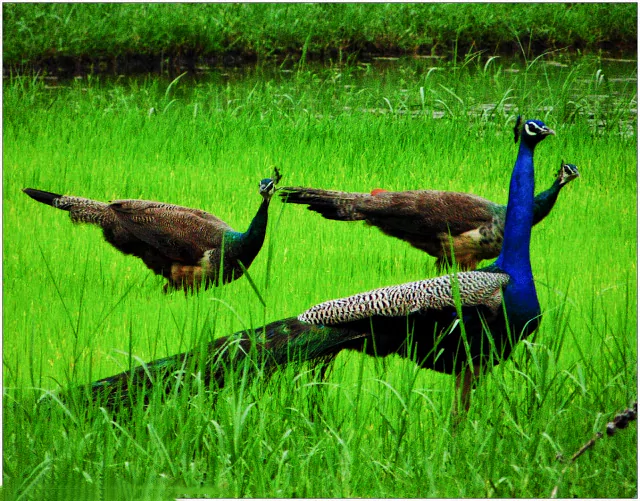
Community Reserves are designated on private or community land, excluding areas within a National Park, Sanctuary, or Conservation Reserve. These reserves emerge when an individual or a community willingly commits to wildlife and habitat conservation efforts. There are 219 existing community reserves in India,covering an area of 1446.28 km2, or 0.043 percent of the country’s geographical area.
Beyond their primary purpose, these areas serve as buffer zones connecting established national parks, wildlife sanctuaries, and reserved and protected forests in India. Importantly, the establishment of a Community Reserve does not impact the rights of individuals residing within its boundaries. For Example– : Lalwan community reserve, Gogabeel in Bihar etc.
Protection level- National Parks > Wildlife Sanctuary > Reserved forests > Protected forests
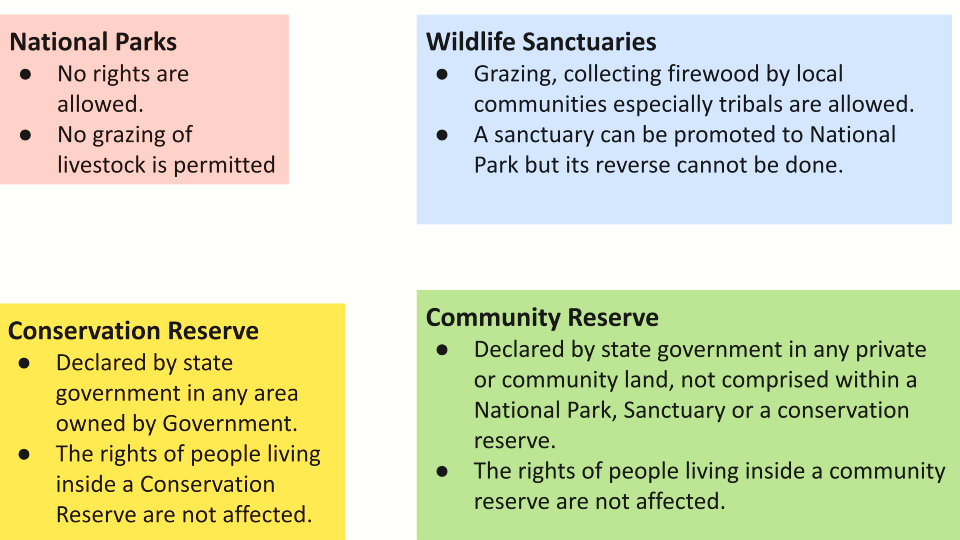
| Protected Areas | No. | % of Area Covered |
| National Parks (NPs) | 106 | 1.35 |
| Wildlife Sanctuaries (WLSs) | 573 | 3.74 |
| Conservation Reserves (CRs) | 115 | 0.16 |
| Community Reserves | 220 | 0.04 |
| Total Protected Areas (PAs) | 1014 | 5.28 |
List of National Parks in India
| Year | Name of National Park | State |
| 1936 | Corbett National Park | Uttarakhand |
| 1955 | Kanha National Park | Madhya Pradesh |
| 1955 | Tadoba National Park | Maharashtra |
| 1959 | Madhav National Park | Madhya Pradesh |
| 1968 | Bandhavgarh National Park | Madhya Pradesh |
| 1974 | Kaziranga National Park | Assam |
| 1974 | Bandipur National Park | Karnataka |
| 1974 | Bannerghatta National Park | Karnataka |
| 1975 | Gir National Park | Gujarat |
| 1975 | Gugamal National Park | Maharashtra |
| 1975 | Navegaon National Park | Maharashtra |
| 1975 | Pench National Park | Madhya Pradesh |
| 1976 | Blackbuck National Park | Gujarat |
| 1976 | Guindy National Park | Tamil Nadu |
| 1977 | Keibul-Lamjao National Park | Manipur |
| 1977 | Khangchendzonga National Park | Sikkim |
| 1977 | Dudhwa National Park | Uttar Pradesh |
| 1978 | Eravikulam National Park | Kerala |
| 1979 | Vansda National Park | Gujarat |
| 1979 | Van Vihar National Park | Madhya Pradesh |
| 1980 | Simlipal National Park | Odisha |
| 1980 | Ranthambore National Park | Rajasthan |
| 1980 | Gulf of Mannar Marine National Park | Tamil Nadu |
| 1981 | Guru Ghasidas (Sanjay) National Park | Chhattisgarh |
| 1981 | Dachigam National Park | Jammu & Kashmir |
| 1981 | Hemis National Park | Jammu & Kashmir |
| 1981 | Kishtwar National Park | Jammu & Kashmir |
| 1981 | Panna National Park | Madhya Pradesh |
| 1981 | Sanjay National Park | Madhya Pradesh |
| 1981 | Satpura National Park | Madhya Pradesh |
| 1981 | Keoladeo Ghana National Park | Rajasthan |
| 1982 | Indravati National Park | Chhattisgarh |
| 1982 | Kanger Valley National Park | Chhattisgarh |
| 1982 | Marine National Park | Gujarat |
| 1982 | Periyar National Park | Kerala |
| 1982 | Nanda Devi National Park | Uttarakhand |
| 1982 | Valley of Flowers National Park | Uttarakhand |
| 1983 | Mahatma Gandhi Marine National Park | Andaman & Nicobar Islands |
| 1983 | Namdapha National Park | Arunachal Pradesh |
| 1983 | Fossil National Park | Madhya Pradesh |
| 1983 | Sanjay Gandhi National Park | Maharashtra |
| 1983 | Rajaji National Park | Uttarakhand |
| 1984 | Great Himalayan National Park | Himachal Pradesh |
| 1984 | Silent Valley National Park | Kerala |
| 1984 | Sunderban National Park | West Bengal |
| 1985 | Balpakram National Park | Meghalaya |
| 1986 | Mouling National Park | Arunachal Pradesh |
| 1986 | Betla National Park | Jharkhand |
| 1986 | Nokrek Ridge National Park | Meghalaya |
| 1986 | Neora Valley National Park | West Bengal |
| 1986 | Singalila National Park | West Bengal |
| 1987 | Middle Button Island National Park | Andaman & Nicobar Islands |
| 1987 | Mount Harriet National Park | Andaman & Nicobar Islands |
| 1987 | North Button Island National Park | Andaman & Nicobar Islands |
| 1987 | Saddle Peak National Park | Andaman & Nicobar Islands |
| 1987 | South Button Island National Park | Andaman & Nicobar Islands |
| 1987 | Pin Valley National Park | Himachal Pradesh |
| 1987 | Anshi National Park | Karnataka |
| 1987 | Kudremukh National Park | Karnataka |
| 1988 | Nagarahole (Rajiv Gandhi) National Park | Karnataka |
| 1988 | Bhitarkanika National Park | Odisha |
| 1989 | Sri Venkateswara National Park | Andhra Pradesh |
| 1989 | Valmiki National Park | Bihar |
| 1989 | Sultan National Park | Haryana |
| 1989 | Indira Gandhi (Annamalai) National Park | Tamil Nadu |
| 1989 | Gangotri National Park | Uttarakhand |
| 1990 | Manas National Park | Assam |
| 1990 | Mudumalai National Park | Tamil Nadu |
| 1990 | Mukurthi National Park | Tamil Nadu |
| 1990 | Govind National Park | Uttarakhand |
| 1991 | Murlen National Park | Mizoram |
| 1992 | Campbell Bay National Park | Andaman & Nicobar Islands |
| 1992 | Galathea Bay National Park | Andaman & Nicobar Islands |
| 1992 | Mollem National Park | Goa |
| 1992 | City Forest (Salim Ali) National Park | Jammu & Kashmir |
| 1992 | Phawngpui Blue Mountain National Park | Mizoram |
| 1992 | Desert National Park | Rajasthan |
| 1992 | Sariska National Park | Rajasthan |
| 1992 | Buxa National Park | West Bengal |
| 1992 | Gorumara National Park | West Bengal |
| 1993 | Intanki National Park | Nagaland |
| 1994 | Kasu Brahmananda Reddy National Park | Telangana |
| 1994 | Mahaveer Harina Vanasthali National Park | Telangana |
| 1994 | Mrugavani National Park | Telangana |
| 1996 | Rani Jhansi Marine National Park | Andaman & Nicobar Islands |
| 1998 | Nameri National Park | Assam |
| 1999 | Dibru-Saikhowa National Park | Assam |
| 1999 | Rajiv Gandhi Orang National Park | Assam |
| 2003 | Kalesar National Park | Haryana |
| 2003 | Anamudi Shola National Park | Kerala |
| 2003 | Mathikettan Shola National Park | Kerala |
| 2003 | Pampadum Shola National Park | Kerala |
| 2004 | Chandoli National Park | Maharashtra |
| 2005 | Rajiv Gandhi (Rameswaram) National Park | Andhra Pradesh |
| 2006 | Mukundra Hills National Park | Rajasthan |
| 2007 | Clouded Leopard National Park | Tripura |
| 2007 | Bison National Park | Tripura |
| 2008 | Papikonda National Park | Andhra Pradesh |
| 2010 | Inderkilla National Park | Himachal Pradesh |
| 2010 | Khirganga National Park | Himachal Pradesh |
| 2010 | Simbalbara National Park | Himachal Pradesh |
| 2014 | Jaldapara National Park | West Bengal |
Forests and wildlife are categorised under the Concurrent List of the Indian Constitution. So the Union government makes policies and plans for Wildlife Conservation whereas the State Forest Departments implant those national policies and plans at the state level.
Tiger Reserve
Eco-Sensitive Zone
Biosphere Reserve
State-wise Protected Sites and Ramsar Sites of India
| Must Read | |
| NCERT Notes For UPSC | UPSC Daily Current Affairs |
| UPSC Blogs | UPSC Daily Editorials |
| Daily Current Affairs Quiz | Daily Main Answer Writing |
Indian Protected areas are those in which human occupation or at least the exploitation of resources is limited. These areas are aimed to preserve and conserve the natural habitat of flora and fauna.
According to the Wildlife Protection Act there are four types of protected areas in India And National Parks, Wildlife Sanctuary, Community reserve and Conservation Reserves.
No, any place is declared a community reserve by the state government which is owned by the government. On the other hand, a conservation reserve declared by the state government on any land owned by state, private and community owned excluding area allotted to national parks, wildlife sanctuaries and community reserves.
Wildlife Protection Act was passed in 1972. It aims to protect wild animals, birds, and plants through protected areas in India, strict trade regulations, and ban hunting.
It was adopted in 1979 in Bonn (Germany). Formally known as Convention on the Conservation of Migratory Species of Wild Animals. It is an international treaty aiming to protect migratory animal species throughout their entire range.
Big game countries typically refers to nations or regions known for their abundant and diverse populations of large, charismatic mammals, often sought after by hunters and wildlife enthusiasts.

<div class="new-fform">
</div>
